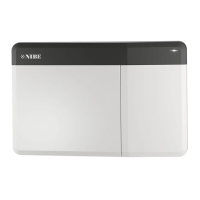Temperature sensor, hot water top
A temperature sensor for hot water top (BT7) can be
connected to SMO S40 to show the water temperature
at the top of the tank (if it is possible to install a sensor
at the top of the tank).
Connect the sensor to terminal block AA100-X10:4 and
to any input on terminal block AA100-X11.
AUX1
AUX2
BT7
BT25
BT71
BT7
AA100-X11
AA100-X10
5
6
7
8
4
Temperature sensor, external flow line
Connect temperature sensor, external supply line (BT25)
to terminal block AA100-X10:5 and to any input on ter-
minal block AA100-X11.
AUX1
AUX2
BT7
BT25
BT71
BT25
AA100-X11
AA100-X10
5
6
7
8
4
Temperature sensor, external return line
Connect temperature sensor, external return line (BT71)
to terminal block AA100-X10:6 and to any input on ter-
minal block AA100-X11.
AUX1
AUX2
BT7
BT25
BT71
BT71
AA100-X11
AA100-X10
5
6
7
8
4
Room sensor
SMO S40 is delivered with an enclosed room sensor
(BT50) that makes it possible to display and control the
room temperature.
Fit the room sensor in a neutral position where a set
temperature is required. A suitable location might be,
for example, on a free inner wall in a hall approx. 1.5 m
above the floor. It is important that the room sensor is
not obstructed from measuring the correct room tem-
perature, for example by being located in a recess,
between shelves, behind a curtain, above or close to a
heat source, in a draught from an external door or in
direct sunlight. Closed radiator thermostats can also
cause problems.
SMO S40 operates without room sensor, but if you want
to read the home’s indoor temperature from the display
on SMO S40, the room sensor must be fitted. The room
sensor is connected on terminal block AA100-X10:2 and
to any input on terminal block AA100-X11.
If a room sensor is to be used to change the room
temperature in °C and/or to fine-tune the room temper-
ature, the sensor must be activated in menu 1.3 "Room
sensor settings".
If a room sensor is used in a room with underfloor
heating, it should only have an indicatory function, not
control of the room temperature.
2
3
4
5
1
BT7
BT25
BT1
BT50
BT6
BT50
AA100-X11
AA100-X10
Caution
Changes of temperature in accommodation
take time. For example, short time periods in
combination with underfloor heating will not
give a noticeable difference in room temperat-
ure.
EXTERNAL ENERGY METER
One or two energy meters (BE6, BE7) are connected to
terminal block AA100-X14:6-7 or AA100-X14:8-9.
+5V
0-5V
0-5V
+5V
BE3
AA100-X14
8
9
5
6
7
+5V
0-5V
0-5V
+5V
BE3
AA100-X14
8
9
5
6
7
+5V
+5V
Activate the energy meter(s) in menu 7.2 and then set
the desired value ("Energy per pulse" or "Pulses per
kWh") in menu 7.2.19.
LOAD MONITOR
When many power consumers are connected in the
property at the same time as the electric additional heat
is in operation, there is a risk of the property’s main
fuses tripping. SMO S40 has an integrated load monitor
that controls the power steps for the electric additional
heat by disconnecting step by step in event of overload
in a phase. Reconnection occurs when other current
consumption is reduced.
Connecting current sensors
A current sensor (BE1 - BE3) must be installed on each
incoming phase conductor into the electrical distribution
unit, to measure the current. The electrical distribution
unit is an appropriate installation point.
21Chapter 5 | Electrical connectionsNIBE SMO S40

